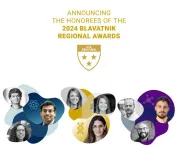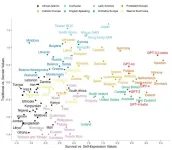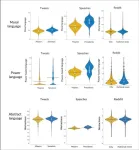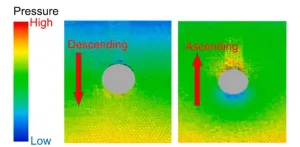(Press-News.org) Images
A key step toward reusing CO2 to make sustainable fuels is chaining carbon atoms together, and an artificial photosynthesis system developed at the University of Michigan can bind two of them into hydrocarbons with field-leading performance.
The system produces ethylene with efficiency, yield and longevity well above other artificial photosynthesis systems. Ethylene is a hydrocarbon typically used in plastics, so one direct application of the system would be to harvest carbon dioxide that would otherwise be vented into the atmosphere for making plastics.
"The performance, or the activity and stability, is about five to six times better than what is typically reported for solar energy or light-driven carbon dioxide reduction to ethylene," said Zetian Mi, professor of electrical and computer engineering at the University of Michigan and corresponding author of the study in Nature Synthesis.
"Ethylene is actually the most produced organic compound in the world. But it is typically produced with oil and gas, under high temperatures and pressures, all of which emits CO2."
The long-term goal is to string longer chains of carbon and hydrogen atoms together to produce liquid fuels that can be easily transported. Part of the challenge is removing all of the oxygen from the CO2 as the carbon source and water, H2O, as the hydrogen source.
The device absorbs light through two kinds of semiconductors: a forest of gallium nitride nanowires, each just 50 nanometers (a few hundred atoms) wide, and the silicon base on which they were grown. The reaction transforming water and carbon dioxide into ethylene takes place on copper clusters, each with about 30 atoms, that dot the nanowires.
The nanowires are submerged in water enriched with carbon dioxide and exposed to light equivalent to the sun at noon. The energy from the light frees up electrons that split the water near the surface of the gallium nitride nanowires. This creates hydrogen to feed into the ethylene reaction but also oxygen that the gallium nitride absorbs to become gallium nitride oxide.
The copper is good at hanging onto the hydrogen and grabbing onto the carbon of the carbon dioxide, turning it into carbon monoxide. With the hydrogen in the mix and an injection of energy from the light, the team believes two carbon monoxide molecules bond together with the hydrogen. The reaction is believed to be completed at the interface between the copper and the gallium nitride oxide, where the two oxygen atoms are stripped off and replaced with three hydrogen atoms from splitting water.
The team found that 61% of the free electrons that the semiconductors generated with the light contributed to the reaction to produce ethylene. While a different catalyst based on silver and copper achieved a similar efficiency of roughly 50%, it needed to run in a carbon-based fluid, and it could function for only a few hours before it degraded. In contrast, the Michigan team's device ran for 116 hours without slowing down, and the team has run similar devices for 3,000 hours.
This is in part because of the synergistic relationship between the gallium nitride and the water splitting process: The addition of oxygen improves the catalyst and enables a self-healing process. The limits of the device's longevity will be explored in future work.
Finally, the device produced ethylene at a rate more than four times higher than the nearest competing systems.
"In the future, we want to produce some other multicarbon compounds such as propanol with three carbons or liquid products," said Bingxing Zhang, U-M assistant research scientist in electrical and computer engineering and first author of the paper.
Liquid fuels, which could enable many existing transportation technologies to become sustainable, are Mi's ultimate goal.
This study was supported by the U.S. Army Research Office.
The device was built in the Lurie Nanofabrication Facility and studied at the Michigan Center for Materials Characterization.
The team has applied for patent protection with the assistance of U-M Innovation Partnerships and is in the process of licensing the technology to NX Fuels, a U-M startup cofounded by Mi. Mi and the University of Michigan have a financial interest in NX Fuels.
Study: Interfacially coupled Cu-cluster/GaN photocathode for efficient CO2 to ethylene conversion (DOI: 10.1038/s44160-024-00648-9)
END
In step toward solar fuels, durable artificial photosynthesis setup chains two carbons together
The system produces ethylene, an important ingredient of many plastics, with much higher efficiency, yield and longevity than competing systems
2024-09-17
ELSE PRESS RELEASES FROM THIS DATE:
Risk of clots, stroke from incorrect blood thinner dosing reduced using online dashboard
2024-09-17
Doctors and pharmacists treating people with blood thinners can reduce the rate of inappropriate dosing — as well as blood clots and strokes that can result from it — using an electronic patient management system, a study suggests.
The online dashboard, developed by the United States Veterans Health Administration in 2016, was designed to highlight and optimize the treatment of patients with direct oral anticoagulants, or DOACs, the most commonly prescribed blood thinners.
Researchers led by Michigan Medicine used the tool to assess over 120,000 cases in which patients with atrial fibrillation or venous thromboembolism, blood clots in the veins, were treated with ...
Juan Jimenez named Blavatnik Regional Awards finalist
2024-09-17
UPTON, N.Y. — The Blavatnik Family Foundation and the New York Academy of Sciences have recognized chemical engineer Juan Jimenez as a Finalist in the 2024 Blavatnik Regional Awards for Young Scientists. Jimenez’s catalysis science research at the U.S. Department of Energy’s (DOE) Brookhaven National Laboratory opens doors for turning climate change-driving gases into industrially useful materials.
The yearly honor is awarded to distinguished early career researchers at institutions in ...
Nine outstanding postdoctoral scholars for the 2024 Blavatnik Regional Awards for Young Scientists announced
2024-09-17
NEW YORK – September 17, 2024 – The Blavatnik Family Foundation and The New York Academy of Sciences today announced the three Laureates and six Finalists of the 2024 Blavatnik Regional Awards for Young Scientists. The Awards honor outstanding postdoctoral scientists from academic research institutions across New York, New Jersey, and Connecticut.
The Blavatnik Regional Awards jury, consisting of distinguished scientists and engineers, selected one Laureate in each category who will receive a $30,000 unrestricted prize and two Finalists in each category who will be awarded $10,000 ...
People underestimate the income of the top 1%
2024-09-17
People selectively underestimate how rich the world’s richest people are, according to a study. Increasing income inequality in many countries is driven by steep gains among the top 1% of earners. In the United States, support for policies that would redistribute wealth has not increased since the 1970s, even as the share of incomes held by the top 1% of Americans jumped from 10% to 19%. Barnabas Szaszi and colleagues conducted four studies to explore how well people understand the wealth held by others. In one study, 990 US residents ...
ChatGPT and cultural bias
2024-09-17
A study finds that ChatGPT expresses cultural values resembling people in English-speaking and Protestant European countries. Large language models, including ChatGPT, are trained on data that overrepresent certain countries and cultures, raising the possibility that the output from these models may be culturally biased. René F Kizilcec and colleagues asked five different versions of OpenAI’s GPT to answer 10 questions drawn from the World Values Survey, an established measure of cultural values used for decades to collect data from countries around the world. The ten questions place respondents ...
National political dialogue focused on power and morals
2024-09-17
A study of political speeches, social media posts from politicians, and Reddit discussions among everyday users finds a higher prevalence of abstract, moralized, and power-centric language in national versus local politics. Political dialogue and debate in the United States has largely shifted from the local to the national in recent years, in part due to the decline of local news media. However, national discussions lack the concrete common ground that comes from shared place-based knowledge. Danica Dillion and colleagues studied how this shift is affecting ...
Police body-camera footage as data
2024-09-17
A study uses body-worn camera footage as a source of data on police-community interactions. Nicholas Camp and colleagues analyzed transcripts from 615 police stops made in California by Oakland Police Department police officers before and after a procedural justice training, which focused on officer communication in routine traffic stops. The training included findings by the authors in a previous study that showed officers used more respectful language with White drivers than with Black drivers during traffic stops. The training ...
Intimate partner violence: Preserving patient privacy saves lives
2024-09-17
Historically, South Carolina has had some of the highest rates of intimate partner violence, or IPV, in the U.S. IPV encompasses any physical or sexual violence, stalking and psychological aggression by a current or previous partner or spouse.
“There is an epidemic of intimate partner violence in South Carolina,” said Leslie A. Lenert, M.D., associate provost of Data Science and Informatics and director of the Biomedical Informatics Center at the Medical University of South Carolina.
To address that epidemic, Lenert partnered with clinical psychologist Alyssa A. Rheingold, Ph.D., family physician Vanessa Diaz, M.D., and health services ...
Moving particle simulation-aided soil plasticity analysis for earth pressure balance shield tunnelling
2024-09-17
Infrastructures often suffer severe damage due to geotechnical hazards of both natural kinds such as floods or earthquakes and man-made ones like underground construction work and excavations. The fields of civil engineering and disaster risk management have extensively studied methods to prevent these risks and are still looking for more effective ways of avoiding large-scale deformations associated with said hazards. The advent of computer-aided simulations has provided researchers with particle-based methods such as moving particle ...
Identifying body-scan postures suitable for people with hyperactivity tendency
2024-09-17
ADHD is a developmental condition of brain with symptoms such as inattention, hyperactivity or impulsivity. People with ADHD lack the ability of self-control and experience anxiety, depression, academic failure, and low self-confidence. These symptoms can be alleviated by a holistic approach such as mindfulness-based stress reduction and mindfulness-based cognitive therapy. These practices encourage patients to pay attention to the present moment with purpose and without judgment. However, these practices involving meditation require sitting in certain postures which can be challenging for patients with high ADHD tendency.
To address this, ...
LAST 30 PRESS RELEASES:
Air pollution exposure and birth weight
Obstructive sleep apnea risk and mental health conditions among older adults
How talking slows eye movements behind the wheel
The Ceramic Society of Japan’s Oxoate Ceramics Research Association launches new international book project
Heart-brain connection: international study reveals the role of the vagus nerve in keeping the heart young
Researchers identify Rb1 as a predictive biomarker for a new therapeutic strategy in some breast cancers
Survey reveals ethical gaps slowing AI adoption in pediatric surgery
Stimulant ADHD medications work differently than thought
AI overestimates how smart people are, according to HSE economists
HSE researchers create genome-wide map of quadruplexes
Scientists boost cell "powerhouses" to burn more calories
Automatic label checking: The missing step in making reliable medical AI
Low daily alcohol intake linked to 50% heightened mouth cancer risk in India
American Meteorological Society announces Rick Spinrad as 2026 President-Elect
Biomass-based carbon capture spotlighted in newly released global climate webinar recording
Illuminating invisible nano pollutants: advanced bioimaging tracks the full journey of emerging nanoscale contaminants in living systems
How does age affect recovery from spinal cord injury?
Novel AI tool offers prognosis for patients with head and neck cancer
Fathers’ microplastic exposure tied to their children’s metabolic problems
Research validates laboratory model for studying high-grade serous ovarian cancer
SIR 2026 delivers transformative breakthroughs in minimally invasive medicine to improve patient care
Stem Cell Reports most downloaded papers of 2025 highlight the breadth and impact of stem cell research
Oxford-led study estimates NHS spends around 3% of its primary and secondary care budget on the health impacts of heat and cold in England
A researcher’s long quest leads to a smart composite breakthrough
Urban wild bees act as “microbial sensors” of city health.
New study finds where you live affects recovery after a hip fracture
Forecasting the impact of fully automated vehicle adoption on US road traffic injuries
Alcohol-related hospitalizations from 2016 to 2022
Semaglutide and hospitalizations in patients with obesity and established cardiovascular disease
Researchers ‘listen in’ to embryo-mother interactions during implantation using a culture system replicating the womb lining
[Press-News.org] In step toward solar fuels, durable artificial photosynthesis setup chains two carbons togetherThe system produces ethylene, an important ingredient of many plastics, with much higher efficiency, yield and longevity than competing systems






